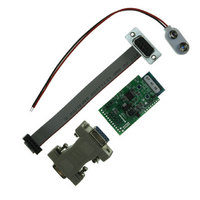RN-134-K Roving Networks Inc, RN-134-K Datasheet - Page 64

RN-134-K
Manufacturer Part Number
RN-134-K
Description
KIT EVAL WIFLY GSX 802.11 RN-134
Manufacturer
Roving Networks Inc
Type
Transceiver, 802.11 b/gr
Specifications of RN-134-K
Frequency
2.4GHz
Wireless Frequency
2402 MHz to 2480 MHz
Interface Type
RS-232, UART
Modulation
CKK, DSSS, DBPSK, DQPSK, OFDM
Security
128 WEP, WPA, TKIP
Operating Voltage
3 V to 12 V
Operating Temperature Range
- 40 C to + 85 C
Lead Free Status / RoHS Status
Lead free / RoHS Compliant
For Use With/related Products
RN-134
Lead Free Status / Rohs Status
Lead free / RoHS Compliant
Other names
740-1035
• When connected over TCP and the AP disappears or WiFly loses association the WiFly will now
Features
• Link monitor The command set wlan linkmon x is now used to monitor the state of the association
• ADHOC mode The command set adhoc probe x is now used to set a threshold for the number of
• DHCP cache The set ip dhcp 3 command is now used to enable DHCP address caching. Once
• ARP table cache The set ip flags 0x20 command is now used to enable ARP table caching. Once
• DNS host address cache. The set ip flags 0x10 command enables DHCP address caching. Once
• UART break detect enables sleep. The command set uart mode 8 enables break detection on the
• UART NOECHO mode. The command set uart mode 1 is now used to disable echoing of RX
set adhoc probe 0 will disable this function. Some Adhoc stations do not reliably respond to
probes and so this value higher avoids intermittent loss of connectivity.
www.rovingnetworks.com
timeout in ms for a join now also applies to the WPA timeout. The default is now 1000ms or 1
second. Note: some APs require up to 1500ms to respond.
closes the connection. The *CLOS* response will now appear when the connection is terminated by
the WIFly. NOTE: This may require the use of the set comm idle xx setting to monitor the TCP
connection, and force a TCP disconnect when no data is flowing due to lost association.
to the AP. The AP is scanned once per second, and if x consecutive scans fail, the WiFly declares
“AP is lost” sets the interface to down state, and enters the association process. Previously the
WiFly would not detect that the AP association was lost until the AP became available again, or the
WiFly was power cycled or rebooted.
consecutive missed probe responses allowed before declaring “ADHOC is Lost” and setting the
network interface to be down. Default is 5 probes. A setting of
caching is turned on, the initial DHCP settings are stored in NVRAM. This is most useful in battery
systems, when using the sleep mode. Upon waking from sleep, as long as the DHCP lease time is
still valid and the WiFly is associated to the same AP, DHCP caching does not survive a power
cycle or usage of the hardware reset pin.
caching is turned on, any ARP table settings are backed up to NVRAM before sleep. Upon waking
from sleep, the ARP cache is loaded. ARP table caching does not survive a power cycle or usage of
the hardware reset pin.
caching is turned on, the initial DHCP settings are stored in NVRAM. This is most useful in battery
systems, when using the sleep mode. Upon waking from sleep, as long as the DHCP lease time is
valid and the WiFly is associated to the same AP, DNS caching does not survive a power cycle or
usage of the hardware reset pin.
UART RX pin. Once Break is detected (a consistent low value on RX pin) ,WiFly waits for the
UART RX pin to return to a high value before going to sleep.
chars while in command mode. This is useful when embedded controllers are used to send
809 University Avenue
•
Los Gatos, CA 95032
~ 64 ~
•
Tel (408) 395-6539
• info@RovingNetworks.com
WiFlyGSX-um
WiFly GSX
9/16/2010




















